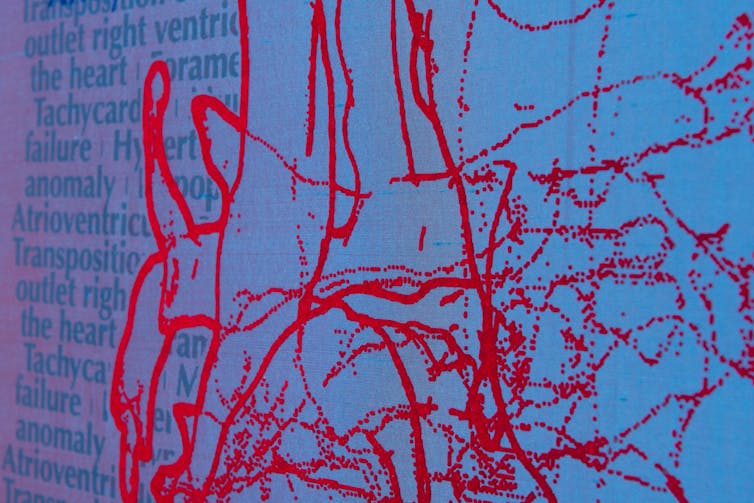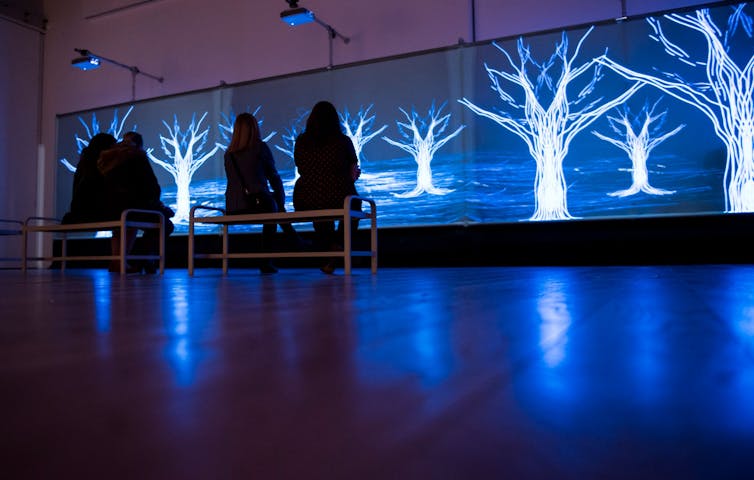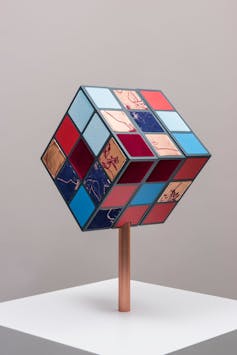When working with people in other disciplines – whether surgeons, fellow engineers, nurses or cardiologists – it can sometimes seem like everyone is speaking a different language. But collaboration between disciplines is crucial for coming up with new ideas.
I first became fascinated with the workings of the heart years ago, during a summer research project on the aortic valve. And as a bioengineer, I recently worked with an artist, a psychologist, a producer, a literature scholar and a whole interdisciplinary team to understand even more about the heart, its function and its symbolism. We began to see the heart in completely different ways. The project, The Heart of the Matter, also involved something that is often missing from discussions purely centred around research: stories from the patients themselves.
The Heart of the Matter originally came out of artist Sofie Layton’s residency at Great Ormond Street Hospital for Children in London a couple of years ago, before the project grew into a wider collaborative effort. For the project, patient groups were engaged in creative workshops that explored how they viewed their hearts. Stories that emerged from these sessions were then translated into a series of original artworks that allow us to reflect on the medical and metaphorical dimensions of the heart, including key elements of cardiovascular function and patient experience.
Below are some of the artworks that emerged from this process and what they tell us about the heart, blood flow, and cardiac surgery and its complexity.
Contours of the heart

The Landscape of Heart Disease: Conditions (detail), 2016, Sofie Layton. Sofie Layton, Author provided
The heart is the pump, the engine room, of our bodies. In The Landscape of Heart Disease, one of the artworks that came out of the project, MRI scans of different hearts are used to produce lines that are interwoven with words. These include key terms that sum up essential elements of the journey of patients born with congenital heart disease – anatomy, conditions, medications, diagnostic techniques and medical devices – and also with narrative snippets from conversations that took place on the hospital wards.
Other lines are presented in different artworks, as maps and architectural drawings, such as in the Blueprints series, where Layton plays with the structural and architectural quality of the organ.
The cardiovascular system

The Bud, 2018, Sofie Layton. Sofie Layton, Author provided
The heart does not operate in isolation, and its structure, as well as the complex network of blood vessels originating from it, can be accurately represented through 3D printing technology.
The Bud is a full-size, 3D-printed model of a heart with congenital disease. It includes the heart, the aorta up to where it bifurcates (divides into two branches) to take blood to the legs, and the renal arteries, which feed the kidneys. The model is shown under a bell jar and represents a collective narrative that emerged during the workshops: several people viewed their hearts as living organisms, plants, buds or trees. As such, the artwork also invites us to reflect on medical language, such as “branching vessels”, “aortic root”, and “pulmonary trunk”.
Blood flow

Flow (soundtrack by Jules Maxwell), 2018, Sofie Layton and Babis Alexiadis. Sofie Layton, Author provided
In Flow, an immersive video installation (a collaboration between Layton, digital animator Babis Alexiadis and composer Jules Maxwell) the concept of blood flowing is reinterpreted to explore the flow of stories, the flow of life. Again, the collaboration between arts and science is evident – the work is inspired by the visual language of advanced imaging techniques such as 4D MRI, which allow us to record and analyse blood flow. An animation incorporates imagery relating to the stories of patients, where the heart becomes an origami bird or whale, where the flow through the pulmonary arteries becomes a forest.
Surgical repair

Sacred, 2018, Sofie Layton. Sofie Layton, Author provided
The surgical theatre, the heart as a work in progress, the sanctity of the operation but also the sanctity of life – these are all themes in another piece central to the exhibition. Sacred is a lightbox installation that represents a cathedral, with cardiac cells as stained glass. Echocardiographic views of the heart morph into beautiful abstract paintings.
The piece is completed by a soundscape (also by Maxwell) in which the voices of the mother of a baby with congenital heart disease, a heart surgeon and a theatre nurse all echo within the walls of the cathedral.
Complexity after surgery
Rubick Heart II, 2018, Sofie Layton. Sofie Layton, Author provided
The act of repairing the heart and the form of the heart after sometimes multiple surgeries is represented here as a Rubick’s cube.
The kinetic sculpture, also inspired by working with a patient and exploring their narrative, represents the effort of bringing the heart back together to its configuration, to an ideal design.
Yet the Rubick’s cube is never fully resolved.



 Citi Sets Bullish 2026 Target for STOXX 600 as Fiscal Support and Monetary Easing Boost Outlook
Citi Sets Bullish 2026 Target for STOXX 600 as Fiscal Support and Monetary Easing Boost Outlook  Novo Nordisk Appoints Greg Miley to Lead Corporate Affairs Amid U.S. Drug Pricing Pressure
Novo Nordisk Appoints Greg Miley to Lead Corporate Affairs Amid U.S. Drug Pricing Pressure  EUR/USD Smashes 1.1660 as ADP Jobs Massacre Crushes the Dollar
EUR/USD Smashes 1.1660 as ADP Jobs Massacre Crushes the Dollar  Novo Nordisk Appoints Greg Miley as Global Head of Corporate Affairs Amid U.S. Pricing Pressure
Novo Nordisk Appoints Greg Miley as Global Head of Corporate Affairs Amid U.S. Pricing Pressure  FDA Pilot Program Eases Rules for Nicotine Pouch Makers
FDA Pilot Program Eases Rules for Nicotine Pouch Makers  Europe Confronts Rising Competitive Pressure as China Accelerates Export-Led Growth
Europe Confronts Rising Competitive Pressure as China Accelerates Export-Led Growth  CDC Shake-Up Sparks Vaccine Policy Clash Between RFK Jr. and Susan Monarez
CDC Shake-Up Sparks Vaccine Policy Clash Between RFK Jr. and Susan Monarez  Novartis to Acquire Avidity Biosciences for $12 Billion to Strengthen Rare Muscle Disorder Portfolio
Novartis to Acquire Avidity Biosciences for $12 Billion to Strengthen Rare Muscle Disorder Portfolio  Pfizer Boosts Bid for Metsera Amid Intensifying Rivalry with Novo Nordisk in Obesity Drug Market
Pfizer Boosts Bid for Metsera Amid Intensifying Rivalry with Novo Nordisk in Obesity Drug Market  Trump Signs Executive Order to Boost AI Research in Childhood Cancer
Trump Signs Executive Order to Boost AI Research in Childhood Cancer  Canada Loses Measles-Free Status After Nearly 30 Years Amid Declining Vaccination Rates
Canada Loses Measles-Free Status After Nearly 30 Years Amid Declining Vaccination Rates  Cogent Biosciences Soars 120% on Breakthrough Phase 3 Results for Bezuclastinib in GIST Treatment
Cogent Biosciences Soars 120% on Breakthrough Phase 3 Results for Bezuclastinib in GIST Treatment  Eli Lilly’s Inluriyo Gains FDA Approval for Advanced Breast Cancer Treatment
Eli Lilly’s Inluriyo Gains FDA Approval for Advanced Breast Cancer Treatment 
































